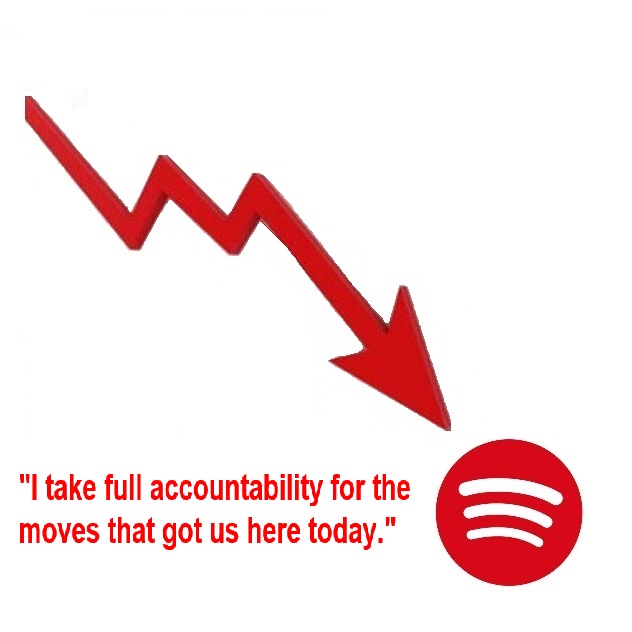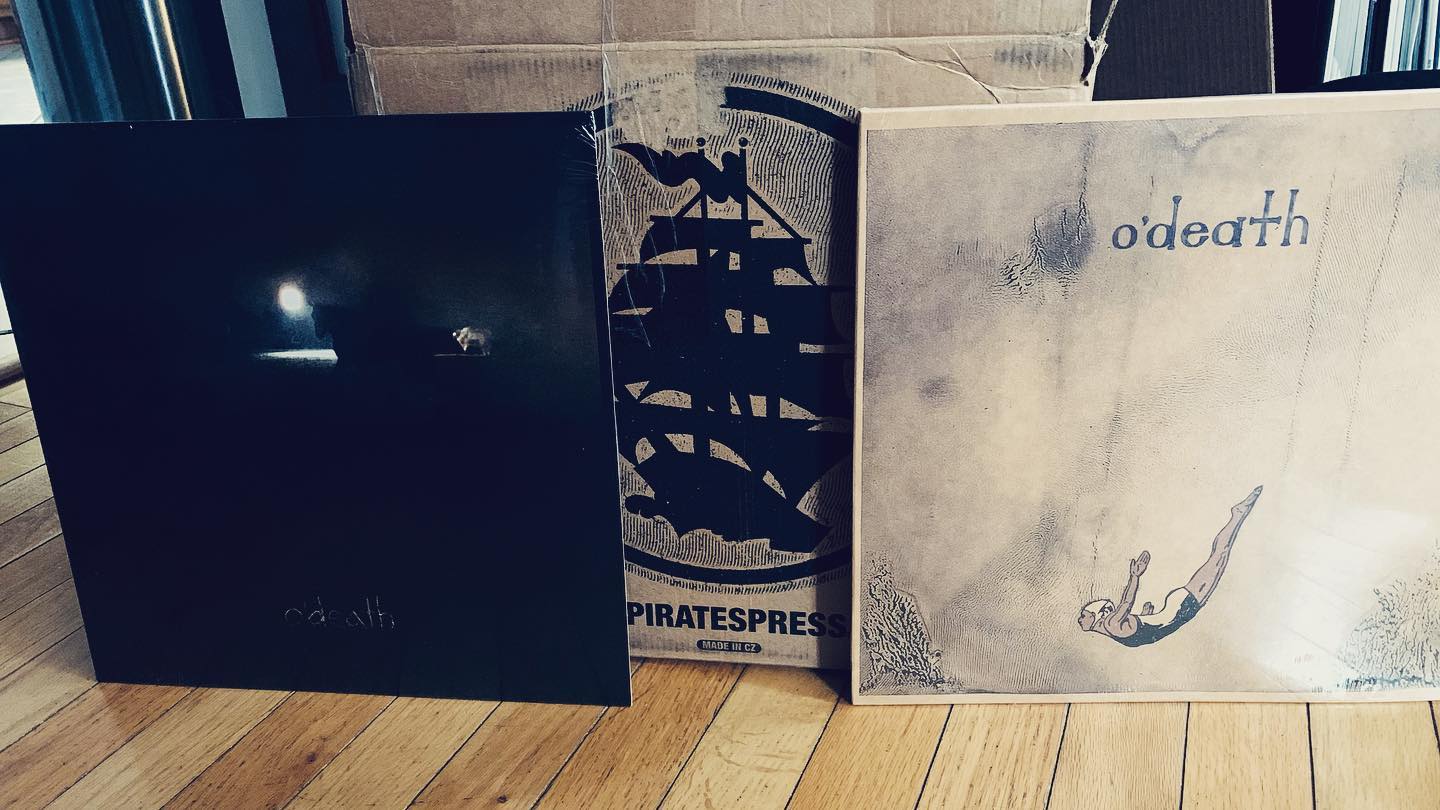 Spotify published their final accounts for 2022. This is not a text for the faint-hearted. They made a huge loss. This comes as no surprise. Spotify presented losses in every quarter. The operating loss amounted to €659m ($706m). The accumulated deficit amounts to €3 647m ($3 908m). You have to wash a lot of dishes to cover this bill. According to the annual report Spotify has 205 million paying (premium) users of a total of 489 million users, which makes 42 percent. The share of paying users has never exceeded 50 percent. Moreover, the tech market analysts have missed that the share of premium users is decreasing (it was 44 percent in 2021 and 45 percent in 2020). The freemium users grows faster than premium users. This isn't sustainable since costs grows faster than revenues. The conversion strategy (by providing freemium, users will upgrade to premium) is nothing more than a mantra. Who wants to invest in Spotify nowadays? Not many. The business share price has plummeted since the introduction in 2018. The annual report provides the following laconic comment in the fine print "We have incurred significant operating losses in the past and may not be able to generate sufficient revenue to be profitable or to generate positive cash flow on a sustained basis. In addition, our revenue growth rate may decline." In any other business the top management would be whipped, keelhauled and then forced to walk the plank. Not in this case. The management takes the opportunity to enrich themselves before the whole shithouse goes up in flames. In fact, their salaries gives the concept of overpaid a new and deeper meaning. Spotify management team is placed no 1, 2 and 7 on the list of the 10 people with highest salaries in 2022 (Sweden). Alex Norström, Chief Business Officer ($30m), Gustav Söderström Chief R&D Office ($28m) and Katarina Berg CHRO ($10m). Spotify have always prioritized growth before revenues. Now everything has come to a grinding halt. Spotify has found out that a company, sooner or later, must operate with efficiency. CEO Daniel Ek said: "I take full accountability for the moves that got us here today." Then he fired six percent of the staff in an insouciant way. In reality this means that he holds his staff, and not himself, accountable. This will not go down in history as a moment of inspiring leadership. Personally, I don't feel sorry for the people being laid off. They chose to work for an unethical and evil company that rips off musicians. Arithmetic is an elementary part of mathematics that consists of the study of the properties of the traditional operations on numbers. The four mathematical operations are addition, subtraction, multiplication and division. The key metrics speaks for itself. Top management needs to do the math.
Spotify published their final accounts for 2022. This is not a text for the faint-hearted. They made a huge loss. This comes as no surprise. Spotify presented losses in every quarter. The operating loss amounted to €659m ($706m). The accumulated deficit amounts to €3 647m ($3 908m). You have to wash a lot of dishes to cover this bill. According to the annual report Spotify has 205 million paying (premium) users of a total of 489 million users, which makes 42 percent. The share of paying users has never exceeded 50 percent. Moreover, the tech market analysts have missed that the share of premium users is decreasing (it was 44 percent in 2021 and 45 percent in 2020). The freemium users grows faster than premium users. This isn't sustainable since costs grows faster than revenues. The conversion strategy (by providing freemium, users will upgrade to premium) is nothing more than a mantra. Who wants to invest in Spotify nowadays? Not many. The business share price has plummeted since the introduction in 2018. The annual report provides the following laconic comment in the fine print "We have incurred significant operating losses in the past and may not be able to generate sufficient revenue to be profitable or to generate positive cash flow on a sustained basis. In addition, our revenue growth rate may decline." In any other business the top management would be whipped, keelhauled and then forced to walk the plank. Not in this case. The management takes the opportunity to enrich themselves before the whole shithouse goes up in flames. In fact, their salaries gives the concept of overpaid a new and deeper meaning. Spotify management team is placed no 1, 2 and 7 on the list of the 10 people with highest salaries in 2022 (Sweden). Alex Norström, Chief Business Officer ($30m), Gustav Söderström Chief R&D Office ($28m) and Katarina Berg CHRO ($10m). Spotify have always prioritized growth before revenues. Now everything has come to a grinding halt. Spotify has found out that a company, sooner or later, must operate with efficiency. CEO Daniel Ek said: "I take full accountability for the moves that got us here today." Then he fired six percent of the staff in an insouciant way. In reality this means that he holds his staff, and not himself, accountable. This will not go down in history as a moment of inspiring leadership. Personally, I don't feel sorry for the people being laid off. They chose to work for an unethical and evil company that rips off musicians. Arithmetic is an elementary part of mathematics that consists of the study of the properties of the traditional operations on numbers. The four mathematical operations are addition, subtraction, multiplication and division. The key metrics speaks for itself. Top management needs to do the math.
 Website traffic analysis allows you to find out the percentage of a target audience that visits your site, the most effective traffic source, session duration, and the number of pages viewed per session. Analytical tools flood the market. Some tools are free, others are not. However, you don't need a very advanced tool to find out that 90,2 percent of the traffic on this website comes from the Westworld. The US stands for 51,2 percent of the total traffic. The Western world, also known as the West, primarily refers to the various nations and states in the regions of Europe, North America, and Oceania. The Western world is also known as the Occident (from the Latin word occidēns "setting down, sunset, west") in contrast to the Eastern world known as the Orient (from the Latin word oriēns "origin, sunrise, east"). The Western dominance is not surprising. We share - more or less - the same history, culture and understanding of the English language. However, it seems like the Russians, Ukrainians and Belarusians also have a soft spot for the gothic country genre. They add another 3,1 percent to the traffic. Moreover, Central and South America add 3,0 percent. Populous countries, like China and India only add 1,1 percent. Apparently, size isn't everything. Gothic country music doesn't seem to be their cup of tea. Some of the visitors protect their integrity through a privacy setting on their IP (not set). This share is small, only 0,4 percent. Should I make an effort to expand in other parts of world? No, I should sit tight. In 1982 Theatre of Hate had a hit with "Do You Believe In The Westworld?". And the answer? Yes, I do.
Website traffic analysis allows you to find out the percentage of a target audience that visits your site, the most effective traffic source, session duration, and the number of pages viewed per session. Analytical tools flood the market. Some tools are free, others are not. However, you don't need a very advanced tool to find out that 90,2 percent of the traffic on this website comes from the Westworld. The US stands for 51,2 percent of the total traffic. The Western world, also known as the West, primarily refers to the various nations and states in the regions of Europe, North America, and Oceania. The Western world is also known as the Occident (from the Latin word occidēns "setting down, sunset, west") in contrast to the Eastern world known as the Orient (from the Latin word oriēns "origin, sunrise, east"). The Western dominance is not surprising. We share - more or less - the same history, culture and understanding of the English language. However, it seems like the Russians, Ukrainians and Belarusians also have a soft spot for the gothic country genre. They add another 3,1 percent to the traffic. Moreover, Central and South America add 3,0 percent. Populous countries, like China and India only add 1,1 percent. Apparently, size isn't everything. Gothic country music doesn't seem to be their cup of tea. Some of the visitors protect their integrity through a privacy setting on their IP (not set). This share is small, only 0,4 percent. Should I make an effort to expand in other parts of world? No, I should sit tight. In 1982 Theatre of Hate had a hit with "Do You Believe In The Westworld?". And the answer? Yes, I do.
![]()
You have to live with the consequences of your actions. It's embarrassing when you praise something that fail to measure up. I wrote a panegyric blog post a couple of years ago about Music Collection (a configurable Music Management System), read more here (opens in a new window). The most valuable feature was the integration with Discogs (importing album data and tracklists automatically). In the blog post I aggrandized the component, calling it the "Rolls Royce" of data-base music products. However, the Discogs integration only worked for a couple of weeks. The developer JoomlaThat! never bothered to fix the integration. Moreover, the component was expensive, $50. I was caught like a donkey between two stacks of hay. I started to enter albums manually. Artist by artist. Album by album. Song by song including adding the exact running time. Monotonous, boring and time-consuming. Ultimately, I had enough. On October 9th 2022 a 404 error message occurred (page not fund or file not found). Apparently, Music Collection didn't survive an update. That was the end of it. I had to find a new solution. A starting point was to minimize duplication of work. I decided to build the Albums section based on the main source, Discogs. In contrast to Music Collection, Discogs works perfectly. In hindsight, it was stupid to buy a product for music management, when a more advanced system already existed. The links in table in the Artists section link to the Artist page on Discogs. The Albums section is completely rebuilt. For every album there's a link to Discogs. Maybe not the most elaborate or aesthetic solution, but it works. The Discogs API lets developers build their own Discogs-powered applications for the web, desktop, and mobile devices. A future alternative is to ask an API-knowledgeable person to write a script. One thing is for sure. I will never buy a component from JoomlaThat! again. I will also be more careful in the future making precipitate assessments. You live and you learn. At least, in theory.
 O'Death released their latest album "Out Of Hands We Go" in 2014. The last time the band played together was on December 1, 2019 (venue: Pete's Candy Store, Brooklyn NY). After that, an indefinite hiatus followed. The band members still perform now and then, either solo or supporting each other in small constellations. But, there's no sign of them coming back as a full band. Their website is active and you can buy some of their cds and vinyls directly from the band. But for how long? A recent Facebook-post sound really ominous "Not sure when we’ll re-stock again, as inventory is starting to run low!" To my knowledge, O'Death have never officially called it quits (or announced a hiatus, for that matter). Not many bands return from a hiatus. The resurrection rate is particularly low in the gothic country genre. And what are the odds for a musical project that started already in 2003? People move on with family, jobs and other project. You don't get rich from this kind of music. On the contrary, you will be poor. And we all have to support ourselves. The total silence and uncertainty is unbearable. That's why an indefinite hiatus is the worst hiatus.
O'Death released their latest album "Out Of Hands We Go" in 2014. The last time the band played together was on December 1, 2019 (venue: Pete's Candy Store, Brooklyn NY). After that, an indefinite hiatus followed. The band members still perform now and then, either solo or supporting each other in small constellations. But, there's no sign of them coming back as a full band. Their website is active and you can buy some of their cds and vinyls directly from the band. But for how long? A recent Facebook-post sound really ominous "Not sure when we’ll re-stock again, as inventory is starting to run low!" To my knowledge, O'Death have never officially called it quits (or announced a hiatus, for that matter). Not many bands return from a hiatus. The resurrection rate is particularly low in the gothic country genre. And what are the odds for a musical project that started already in 2003? People move on with family, jobs and other project. You don't get rich from this kind of music. On the contrary, you will be poor. And we all have to support ourselves. The total silence and uncertainty is unbearable. That's why an indefinite hiatus is the worst hiatus.
 The Devil Makes Three (TDM3) will be touring in Europe during May-June 2023. This is exiting news, indeed. They will tour in Scandinavia (Sweden and Norway) for the very first time. The festival organizer is Sthlm Americana (a contradiction in terms) and behind them, a company called Northern Trail (sounds like a shell company). Sthlm Americana are completely clueless. Their copywriting is terrible. They put the artists bios into Google Translate. Well, shit in - shit out. The artists bios are filled with copious amounts of drivel, phrase and platitude. TDM3 are known for their energetic live performances. Unfortunately, there's one tiny detail. The ticket price is set to 1 900 SEK (approximately $180) plus an administrative fee! The explanation to the horrendous ticket price is that it's a festival with several bands and artists. You can't buy a ticket for a single band. You could initially buy a cheaper ticket (early bird offer). The first offer was 1 400 SEK (approximately $133), while the second offer was 1 650 SEK (approximately $157). The early bird tickets were few and got sold out. TDM3 was the first band to be announced. Speaking about buying a pig in a poke. There are no economies of scale here. I couldn't care less about the other performing bands and artists. What trick are they trying to pull here? This is a shameless attempt to capitalize on "country music" (think Doug Seegers). TDM3 are a great band, but they are not worth $180. This must be the most expensive concert ticket of all time. For the genre, that is. According to the site seatgeek.com, The Devil Makes Three tickets can typically be found for as low as $26, with an average price of $89 in the US. Overpricing is a reason to keep the audiences away from attending physical events. In the gothic genre we remember betrayals and injustices, and seek revenge. The North remembers.
The Devil Makes Three (TDM3) will be touring in Europe during May-June 2023. This is exiting news, indeed. They will tour in Scandinavia (Sweden and Norway) for the very first time. The festival organizer is Sthlm Americana (a contradiction in terms) and behind them, a company called Northern Trail (sounds like a shell company). Sthlm Americana are completely clueless. Their copywriting is terrible. They put the artists bios into Google Translate. Well, shit in - shit out. The artists bios are filled with copious amounts of drivel, phrase and platitude. TDM3 are known for their energetic live performances. Unfortunately, there's one tiny detail. The ticket price is set to 1 900 SEK (approximately $180) plus an administrative fee! The explanation to the horrendous ticket price is that it's a festival with several bands and artists. You can't buy a ticket for a single band. You could initially buy a cheaper ticket (early bird offer). The first offer was 1 400 SEK (approximately $133), while the second offer was 1 650 SEK (approximately $157). The early bird tickets were few and got sold out. TDM3 was the first band to be announced. Speaking about buying a pig in a poke. There are no economies of scale here. I couldn't care less about the other performing bands and artists. What trick are they trying to pull here? This is a shameless attempt to capitalize on "country music" (think Doug Seegers). TDM3 are a great band, but they are not worth $180. This must be the most expensive concert ticket of all time. For the genre, that is. According to the site seatgeek.com, The Devil Makes Three tickets can typically be found for as low as $26, with an average price of $89 in the US. Overpricing is a reason to keep the audiences away from attending physical events. In the gothic genre we remember betrayals and injustices, and seek revenge. The North remembers.
